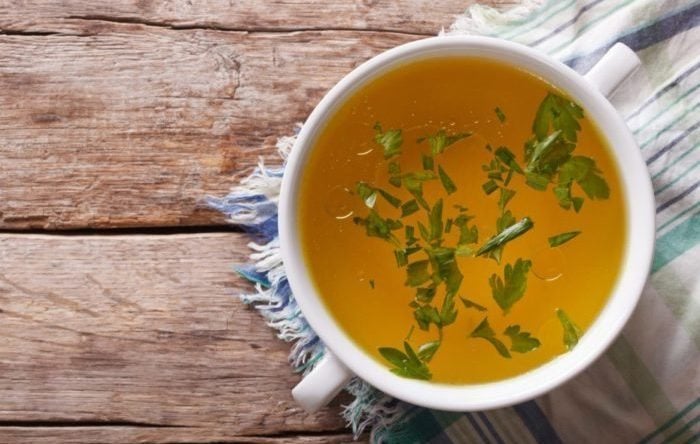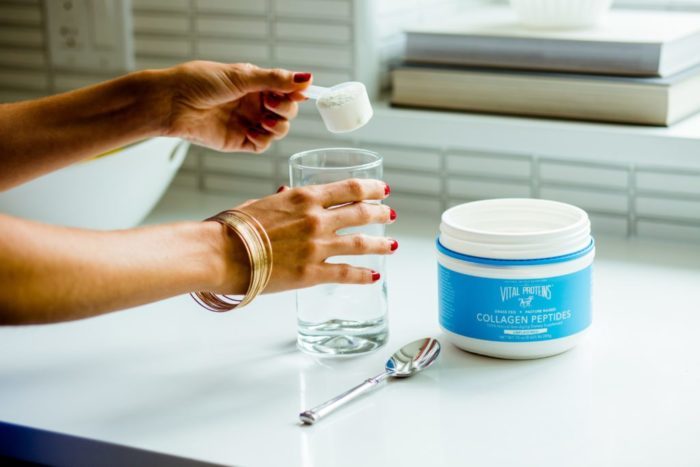
What You Need To Know:
- Collagen is a protein that builds skin, bones and collective tissue.
- As we get older, we make less collagen, resulting in wrinkles, thinner hair and more brittle bones.
- Foods high in vitamin C and sulfur aid in the development of collagen as do some bone broths and collagen protein powders and supplements.
Published on Clean Plates
Collagen creams and pills have been around for years, but now it seems like everyone from Busy Phillips to dermatologists to your in-the-know coworker wants you to eat collagen protein powder and sip bone broth to keep your skin youthful.
“Collagen is a protein that’s a major building block of your skin, bones, and connective tissue,” Kellyann Petrucci, a naturopathic doctor and author of Dr. Kellyann’s Bone Broth Diet, tells Clean Plates. “As we age, our bodies make less and less collagen. As a result, we start getting wrinkles, our hair gets thinner and weaker, and our nails aren’t as strong. This is why it’s smart to start adding collagen to your diet as you age—especially once you’re past 30.”
She recommends having at least one cup of bone broth (like the one below) and a collagen supplement or collagen protein powder daily, along with applying lotion with collagen topically. “That way, you’re loading your skin with collagen inside and out,” Petrucci says. “But bone broth and collagen supplements are more effective, because they strengthen your skin from the inside.”
Skin care therapist Julia March also recommends both eating your collagen and using creams. “The best results are achieved when we double the effort,” she says.
WHAT THE RESEARCH SAYS
Although bone broth has received a lot of press, and has been a culinary and medicinal staple for centuries (though it’s just been called stock, the sexier name “bone broth” is newer), there haven’t been any major scientific studies to support the many health claims made around it. However, there is some research on collagen supplements.
In a 2014 study, women took either a 2.5- or 5-gram collagen hydrolysate supplement or a placebo daily for eight weeks. Both collagen groups saw significant improvements in skin elasticity, researchers reported. In another study, women who took supplements made from either pig or fish collagen peptides had improved skin hydration and collagen density after two months of taking the pills.
“In plain English, collagen supplementation can make your skin more elastic, more dewy, and less wrinkly. It does this by strengthening the collagen matrix in your skin,” Petrucci explains.
However, this doesn’t mean that just any supplement—or collagen protein powder or bone broth—has the same effect.
“Our research focuses on specific collagen peptides,” says Steffen Oesser, PhD, director of the Collagen Research Institute in Kiel, Germany. “We found out that different collagen peptides or collagen hydrolysates could have different effects in terms of their efficacy, and some collagen peptides had no effects,” says Osser.
Oesser adds that although topical beauty products can temporarily help reduce wrinkles, the specific collagen peptides he has studied have longer-term effects. “These peptides are absorbed, distributed, and accumulated in the skin, improving skin elasticity and decelerating wrinkle formation from within,” he explains. It’s important to note that lotions only target your epidermis, the outer layer of the skin. “So maybe a combination of both completely different approaches could make sense,” Oesser says.
Foods high in vitamin C, such as citrus, red peppers, strawberries, guava and kale as well as foods high in sulfur, such as broccoli, cauliflower, arugula and garlic aid in the development of collagen. “In general, eating lots of veggies and a variety of fruits will enhance collagen production,” Petrucci says. Cutting sugar is also helpful as sugar destroys collagen and elastin.
WHAT TO WATCH OUT FOR
One thing experts warn about is using collagen or other supplements to “fix” thinning hair, brittle nails, and other things that could point to an underlying health concern.
“Your body doesn’t care what your hair looks like, it cares about keeping you alive,” says naturopathic and functional medicine doctor Brooke Kalanick. “You need to address the underlying reason your hair is falling out or your nails aren’t strong. Bone broth alone isn’t enough to help most people get on top of things that are internally wrong.”
THE BOTTOM LINE
Whether or not to try consuming collagen comes down to personal preference. “For the average person, I don’t see a real downside to using it, other than the cost,” Kalanick says. “It’s great when you have a study to support something, but people report benefits, and that counts, too.”
If you choose to buy a collagen protein powder, experts recommend looking for grass-fed, organic, hormone-free beef collagen such as Vital Proteins Collagen Powder. You can sprinkle it on oatmeal, blend it into smoothies or Bulletproof coffee, or bake a bit into muffins. (Although plant-based collagen is not as effectively absorbed as the animal-based version, you can try the supplement Reserveage Ultra Collagen Booster.)
Inspired? Check out more on this topic and other delicious superfood recipes, here

- SERVES: MAKES ABOUT 6 QUARTS | TOTAL TIME: 5 HOURS 30 MINUTES
- ACTIVE TIME:10 MINUTES
Ingredients
- 3 pounds chicken feet
- 5 pounds chicken wings
- 7 pounds chicken backs and necks
- 3 large onions, peeled and roughly chopped
- 6 celery stalks, roughly chopped
- 2 large carrots, scrubbed and coarsely chopped
- 5 bay leaves
- 1 tablespoon black peppercorns
- 1 bunch flat-leaf parsley
- Fine sea salt
Directions
- Place all the chicken parts in a 16-quart pot and add cold water to cover by 2 to 3 inches. Bring it to a boil over high heat, about 1 hour, skimming off the foamy impurities every 15 to 20 minutes.
- As soon as the liquid boils, reduce the heat to low and pull the pot to one side so it is partially off the burner. Simmer for 1 hour 30 minutes, skimming once or twice.
- Add the onions, celery, carrots, bay leaves, peppercorns, and parsley and push them down into the liquid. Continue to simmer for 3 to 5 hours, checking once or twice to make sure that the bones are still fully submerged.
- Use a spider skimmer to remove the solids and discard. Strain the broth through a fine-mesh strainer. Season with salt to taste and let it cool.
- Transfer the cooled broth to storage containers (leaving any sediment in the bottom of the pot) and refrigerate overnight. Spoon off any solidified fat. Store the broth for up to 5 days in the refrigerator or freeze for up to 6 months.
More of the latest healthy recipes, tips and nutrition news:
Connect With Us
Join the community at Clean Plates on Facebook
Follow Clean Plates on Instagram
